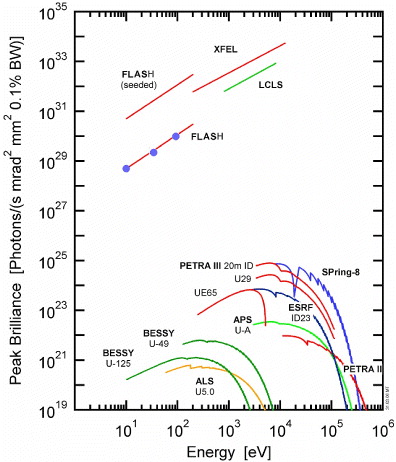European X-ray Free Electron Laser (EuXFEL)
The European X-ray Free Electron LASER (EuXFEL) being constructed at DESY, Hamburg, will benefit many areas of science, from creating extreme states of matter in plasma physics to probing currently inaccessible molecules in structural biology and investigating the structure of large biomolecules such as proteins. The cartoon shows how a photon beam impacts on a sample and the diffractive pattern is read out in large, digital cameras.

The EuXFEL project is a large-scale facility using high intensity, high energy beams usually only associated with particle physics experiments. The accelerator will be 3.4 km long using novel superconducting RF technology to accelerate electrons to high energy. The electrons will then pass through an undulator, causing them to oscillate and emit LASERlike photons. When it turns on in 2017, the EuXFEL will provide a beam 100 million times more brilliant than current synchrotron sources (see below). To measure the effect of the impact of the particle beam on the various samples, larger Megapixel detectors will be used to reconstruct an accurate diffractive image.
A bunch of about 1010 electrons will be accelerated via the superconducting magnets, with each bunch temporally separated by about 200 ns. There will be a "train" of about 3000 bunches with a frequency on 10 trains per second. This leads to about 30,000 LASERlike flashes per second. Given such a high number of flashes per second and that the detectors will have 1 million channels each, this constitutes a huge amount of data, potentially 1000s of terabytes per day, to be read out. This will pose a challenge to a data acquisition system which will have to cope with these high data rates and be able to handle different (Megapixel) detectors.

As part of the work on the readout and control of the data, UCL is designing and building the interface between the accelerator and detectors, the clock and control system, which ensures the detectors know when to expect data.
The other part of the UCL activity is the simulation of the megapixel detectors and understanding the physics of low-energy photons in silicon. This is encompassed in the X-ray Camera Simulation Toolkit (X-CSIT) developed as a collaboration between UCL and EuXFEL.
